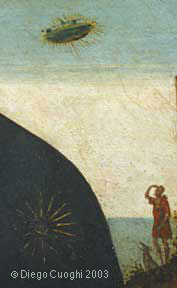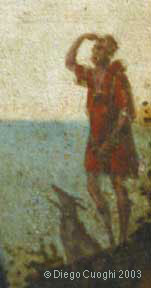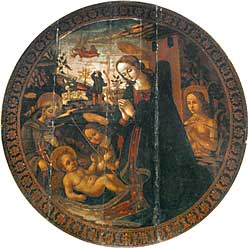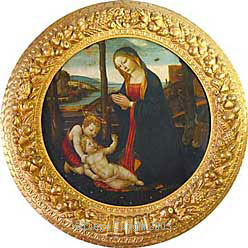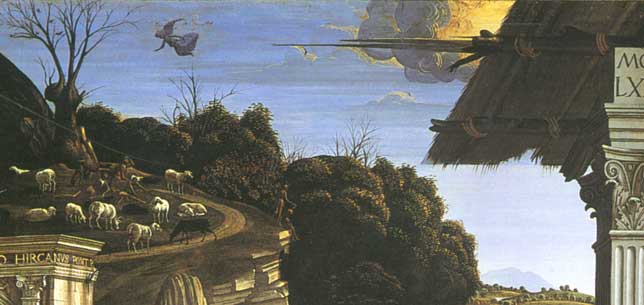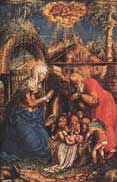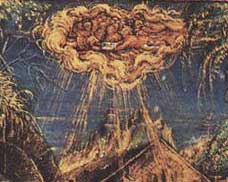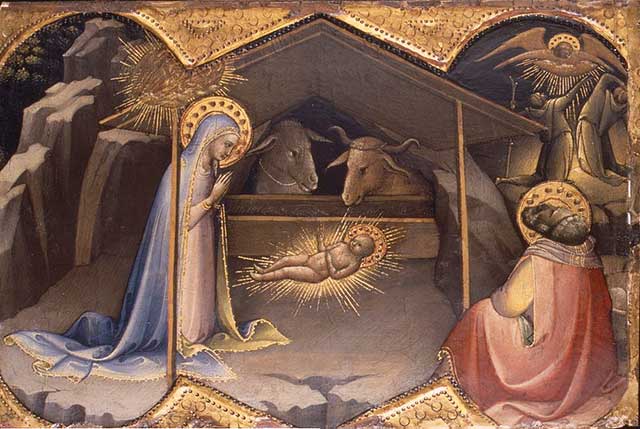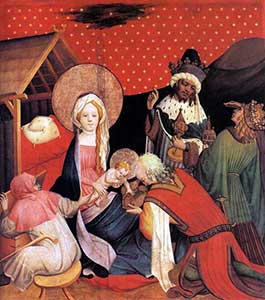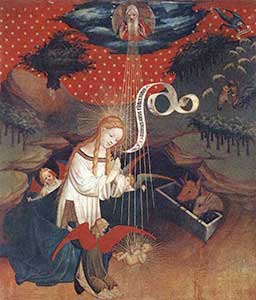Diego Cuoghi
ART and UFOs?
no thanks, only art...(Translation: Leonardo Serni)
MADONNA COL
BAMBINO E SAN GIOVANNINO
(Madonna and Child with the Infant Saint John)
Attributed to Sebastiano Mainardi
or Jacopo del Sellaio
(Firenze, Palazzo Vecchio Museum, Sala d'Ercole)
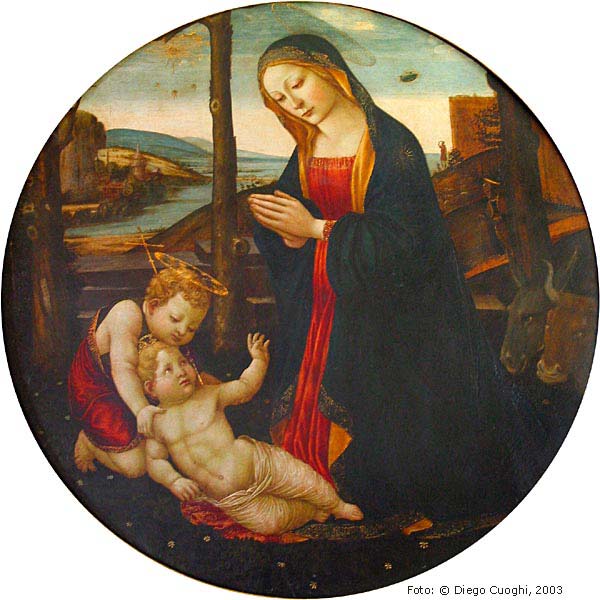
The Madonna and Child with
the infant St. John, on display in the Sala d'Ercole in Palazzo Vecchio,
Florence, has been variously attributed. The Museum tag says "Jacopo
del Sellaio", but the catalog entry under no. 00292620 reads
that the painting is best attributed to Sebastiano Mainardi (1466-1513), member of the clique of Ghirlandaio that worked
in Florence at the end of '400. It is also stated that there are some remarkable
resemblances with works of Lorenzo
di Credi, especially in the figure of the Madonna.
This is the painting that more than any other has sparked discussions among
ufologists, who see in the upper-right scene behind the Madonna the proof
of a "close encounter" with an un-identified flying object. In the
above mentioned scene we see a character keeping a hand to his forehead and
looking towards an apparition in the sky. With him there is a dog, which also
looks towards the strange object.
In an article
by Daniele Bedini on Notiziario
UFO n. 7 (Jul-Aug 1996) it says: «we clearly see the presence
of an airborne object leaden in color and inclined to port, sporting a "dome"
or "turret", apparently identifiable as an oval-shaped moving flying
device».
But this is not the only peculiarity of the painting: for example, to the upper left we see the Nativity Star with three other small stars, or perhaps flames.A very similar detail is present in the Madonna of the Book (1480) by Sandro Botticelli
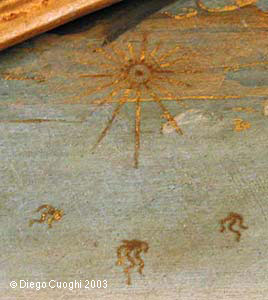
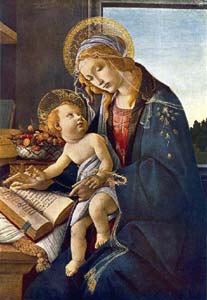
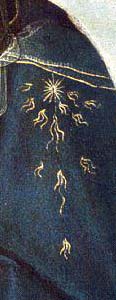
These particulars - three stars,
a luminous cloud - tell us that this painting follows an ancient iconography,
an austere and rigid way for interpreting not only sacred subjects but city
life itself, which had been preached by Fra' (Brother) Girolamo Savonarola,
and precisely in the Florence of the end of the 15-th century. After the Medici
family had been driven out, Florence declared the Republic, which Savonarola
oriented in a teocratic fashion, exerting a pervasive surveillance of the
people and their ways (nowadays we could draw a parallel with the Islam fundamentalists
of Ayatollah Khomeini's Iran Republic), even to the point of the "vanity
bonfires", where game cards, dices, wigs and fineries together with trinkets
and baubles, books considered obscene and even pictures and precious objects
were gathered and set on fire.
Savonarola's preachings greatly influenced works of art of the period and
several artists, for example Sandro Botticelli, reneged their own preceding
works as heathen, and set to represent mystical
subjects in a "purer", but also more rigid, archaic and didascalic
style.
The religious symbology which we find in this Madonna is therefore in line with this older iconography that in the Florence of the humanism and Neo-Platonism had been lost. The three stars, for example, appear often in the paintings of the previous century, and especially in the byzantine icons of the Madonna; often, they were painted on her veil, on the shoulders and forehead; other times they are replaced by three rays; they always represent the "threefold virginity" of the Madonna, i.e., before, during, and after the virgin birth. The three stars, in the same meaning, are also found on the coat of arms of the Oratorian order of Saint Filippo Neri (hence, also called "Filippini"), who are particularly devout to the Madonna.
Returning to the above mentioned detail, the one that was interpreted as an UFO, we see that it is to be found in a great many "Nativities" of the '400 and '500. It is but the announcement to the shepherds, as told in St. Luke's Gospel:
«...and there were in the same country shepherds abiding in the field keeping watch over their flock by night. And lo, an angel of the Lord come upon them, and the glory of the Lord shone round about them: and they were sore afraid. And the angel said unto them, Fear ye not: for behold!, I bring you good tidings of great joy, which shall be to all people. For unto you was born this day in the city of David a Savior, which is Christ the Lord...»
The announcement to the shepherds as appears in the Nativity of Vincenzo Foppa (Detroit Institute of Arts):
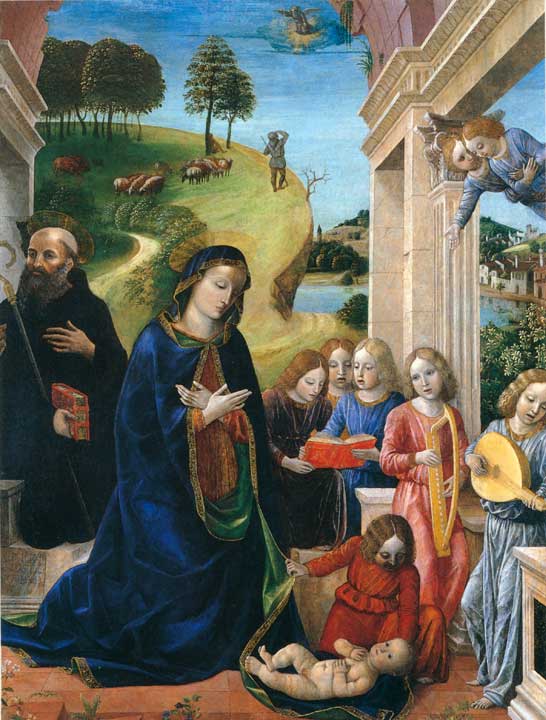

Two shepherds, as in the tondo of Palazzo Vecchio, are looking to the angel coming out from the cloud. We can see this scene represented in much the same way of the Madonna with Child of Palazzo Vecchio in many other paintings of the Nativity or the Adoration of the Child:
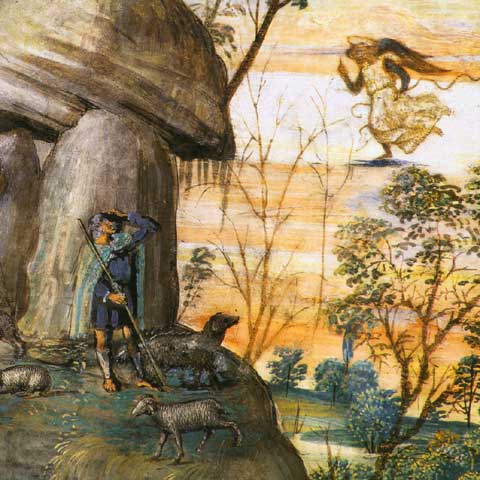 |
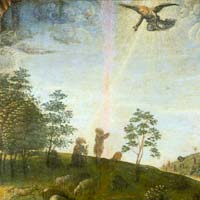 |
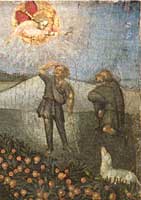 |
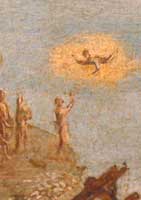 |
Pinturicchio |
Vincenzo
Foppa |
Giovanni
Di Paolo |
Amico Aspertini |
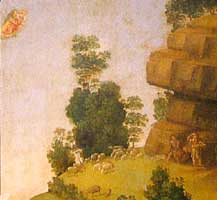 |
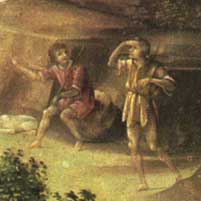 |
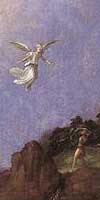 |
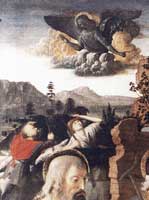 |
Lorenzo
Di Credi |
Lorenzo
Di Credi (part.) |
Agnolo
Bronzino |
Antoniazzo
Romano |
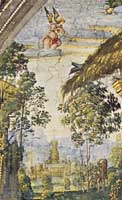 |
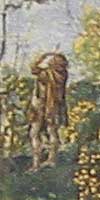 |
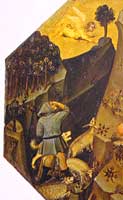 |
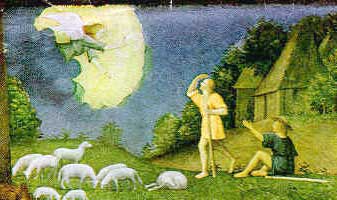 |
Pinturicchio |
Pinturicchio
(part.) |
Maestro
della predella |
Bernardino
Luini |
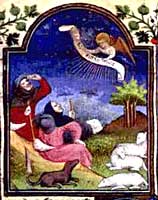 |
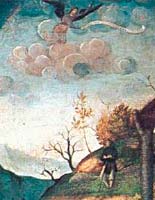 |
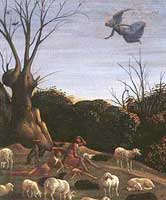 |
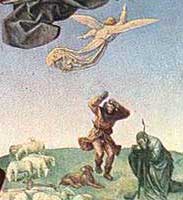 |
miniatura
sec XV |
Bernardino
Fasolo |
Domenico
Ghirlandaio |
Hugo Van
Der Goes |
These above are but a few examples, taken from dozens of paintings of the Nativity of Christ. In every one, we clearly recognize the Angel, and see that almost always there's one shepherd holding a hand to his forehead, as if shielding his eyes from the light of the Glory of the Lord referred to in the above quote from the Gospel. Often there will also be a dog looking towards the apparition. In many cases the Angel comes out of a cloud lined by light, or, in older pictures, by golden rays.
In an illumination from "Grandes Heures d'Anne de Bretagne" (1500-1508) by Jean Bourdichon, an angel appears through light tear in the sky, while in a Madonna and Child with the infant St. John by Raffaellino del Garbo there is only the luminous tear in a big cloud:
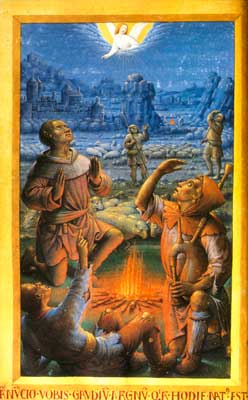

Also another "tondo", attributed to the school of Sebastiano Mainardi and on display at Sommariva Perno, shows the same scene of a shepherd who, with a hand to his forehead and a dog at his side, looks towards the apparition of the red-dressed Angel. And in the center, above the Madonna's head, there is the same light-rayed cloud.
Sebastiano Mainardi was Domenico Ghirlandaio brother-in-law. Here it is a Nativity of Ghirlandaio, with a bright star appearing inside a cloud; on a hill at right the angel appears to the shepherds:
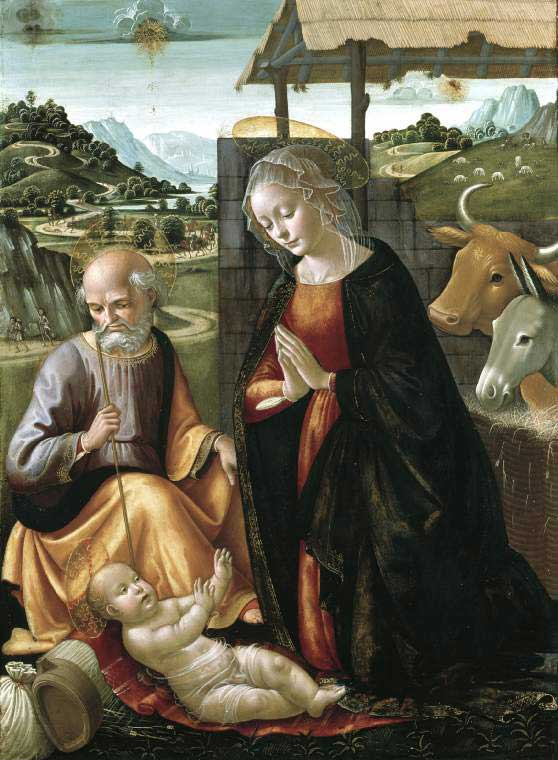
Also in the Adorazione dei Magi by Domenico Ghirlandaio we find both the angel and the luminous cloud, and even in this painting someone finds "unidenitified fliying objects" (http://www.teegeeack.com/alien-ufo-secret-ufo-video-photo.html)
Also in this Nativity, from a Book Of Prayers of Sforza family (1500), we recognize the luminous cloud, full of little angels:
In the Nativity by Lorenzo Monaco (1409), we find the same cloud over the Madonna, while the Angel comes out of a similar cloud to make his announcement to the shepherds.
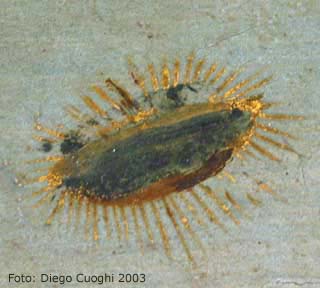
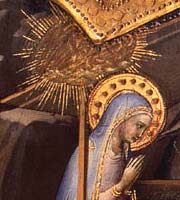
We can therefore safely identify in the Madonna and Child with the Infant St. John exposed in Palazzo Vecchio the same announcement scene which is described by the Gospel of Luke. But one might wonder, since there is no talk of "luminous clouds" in Luke, whence could this particular have come from?
In the Renaissance sacred art, there were represented not only scenes taken from the four canonical Gospels. Artists, often,took their inspirations from more recent devotional texts, containing characters and situations with more popular and narrative streaks. To these texts we owe Mary's Presentation to the Temple, or the Virgin's Wedding, painted by Giotto; the encounter between Jesus and Saint John the Baptist painted by Leonardo in "The virgin of the rocks"; are all subjects deriving from sources extraneous to the Gospels of Mark, Matthew, Luke or John. Painters (and their employers, who decided the subjects) often mixed scenes and situations from heterogeneous texts, for example the "Golden Legend", by Jacopo da Varazze, or the several apocryphal gospels.
One of the apocryphal gospels
most heavily used as source of subjects for the artists of this period is
James'
Protogospel. And it is there that we find a description of the Nativity
in which no angels appear, replaced by (you guessed it) a cloud of light
as well as a mid-wife:
[19, 2] «They stood in the place of the cave, and behold!, a luminous
cloud over-shadowed the cave. And the mid-wife said: My soul has beenmagnified
this day, because mine eyes have seen wondrous things: that salvation has
been brought forth to Israel. And immediately the cloud disappeared out of
the cave, and a great light shone in the cave that the eyes could not bear
it» ("Apocryphal Gospels", edited by Marcello Craveri,
Torino, 1969, p. 21 italian edition).
We notice a difference from St. Luke, who said that «and the glory of he Lord shone round about them». Here, the author adds that «the eyes could not bear it». And behold!, in many paintings we can see how the shepherd doth shadow his eyes with the hand.
In the same Protogospel we find
a description of the Star, but what's more, we also read how the infant St.
John had to flee from Herod:
[22, 1] «And, when Herod knew that he had been mocked by the Magi,
in a rage did he send murderers saying unto them: Slay the children from two
years old, and under. [2]And Mary, having heard that the children were being
killed, was afraid, and took the infant, and swaddled Him, and put Him into
an ox-stall. [3]Elizabeth too having heard that they were searching for John,
took him, and went up into the hill-country, and kept looking for where to
conceal him. But, there was no place of concealment. And, Elizabeth groaning
in a loud voice said: O Mountain of God, receive a mother and her child! And,
immediately the mountain was cleft and received her. And a light shone about
them for an Angel of the Lord was with them to watch over them.»
And it came to pass, that in this passage of the Protogospel of James the
light was identified with a guardian angel, without him appearing in person.
The depiction of the cloud alone, without the Angel, is rare, but one example can be seen in a painting by Master Franke, on the Adoration of the Child. This same author elsewhere shows God Himself within the cloud, while an angel makes the announcement to the shepherds:
Marco Bussagli wrote several books on the iconography of the Angels. In particular in "History of Angels" (Rusconi, 1991) he quotes pseudo Dionigi stating that: «The Holy Scriptures represent them in the form of clouds to indicate that the holy entities are filled with a hidden light in an above-mundane way, and simply host the first light at its first emanation...». The same Bussagli, in the catalogue of "Wings of God", writes: «All things considered the Middle Ages turned out to be a central period for the development of the Angels iconography, whose solutions were to be re-interpreted in a markedly naturalistic way by the later culture of Renaissance and Baroque. Such is the case of the 'Cloud Angels', that would be later propounded as winged figures over soft cushions of vapour.» (http://www.enec.it/AliDio/09e_Iconografia.pdf)
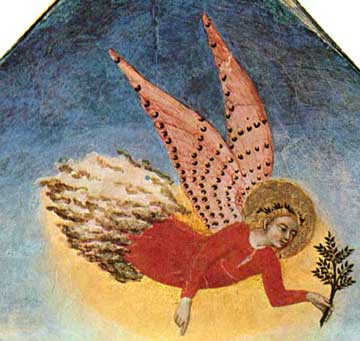
Sano di Pietro, the Angel from "Annunciation
to the Shepherds" (mid XV century)
We can, then, link the "tondo" with the Madonna and Child with the Infant St. John with the iconographical tradition of that period, the end of the '400 in Florence. The archaic detail of the three stars symbol of the threefold virginity of Mary, and the painting of the Angel not as an anthropomorphic character but as a "cloud of light", make us think of an adhering on the part of the author to the teachings of Girolamo Savonarola, the Domenican monk who preached a return to tradition and purity in the arts as well as in city life. In the catalogue entry of the Palazzo Vecchio Museum for this painting, it reads that there are "striking similarities" with works of Lorenzo di Credi. And it may be worthy of note that Lorenzo di Credi was one of the most devout among the followers of Savonarola, arriving to the burning of every drawing of nude he ever made, and finally to becoming himself a monk.
Conclusions:
In the painting named Madonna and Child with the Infant St. John, probably made by Sebastiano Mainardi (school of Ghirlandaio) there are no UFOs. The three little stars under the great Nativity Star are symbols of the triple virginity of Mary (before, during and after the childbirth), The shepherd with the hand on the forehead is similar to many other shepherds in dozens of Nativity or Adoration paintings of the same age; and the lighting cloud, symbol of the God's Glory, comes from the narration of the nativity in the Protogospel of James (chapter 2, 19).
Other works of Diego Cuoghi:
I MISTERI DELLA MAPPA DI PIRI REIS
